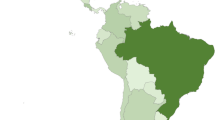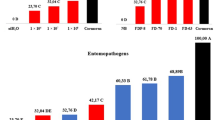Abstract
Phytophagous mites especially yellow mite, Polyphagotarsonemus latus (Banks) and two-spotted spider mite, Tetranychus urticae Koch cause major problems in the cultivation of capsicum or green pepper under protected conditions resulting in significant yield losses. The objective of this study was to evaluate the efficacy of different biorationals and natural products against yellow mite, P.latus, infesting capsicum grown in hydroponic system in polyhouse conditions during 2019. The natural products and plant extracts were prepared indigeneously. Results revealed that among all the treatments, pepper extract @ 30ml/l followed by both Brahamastra and Agniastra at the highest doses of 50ml/l caused maximum mortality of mites. Even the PAU home made neem extract and Pongamia extract both @ 12ml/l were found more effective as compared to the Dherek extract. The bioagent, anthocorid bug, Blaptostethus pallescens @ 10 nymphs per plant reduced the mite population after two releases at weekly interval. These natural products and biorationals can be incorporated in integrated mite management programmes under protected cultivation.
Similar content being viewed by others
References
Attia S, Grissa KL, Lognay G, Bitume E, Hance T, Maileux AC (2013) A review of the major biological approaches to control the worldwide pest Tetranychus urticae (Acari : Tetranychidae) with special reference to natural pesticides. Journal of of Pest Science 86:361–386
Bezzar-Bendjazia R, Kilani-Morakchi S, Maroua F, Aribi N (2017) Azadirachtin induced larval avoidance and antifeeding by disruption of food intake and digective enzymes in Drosophila melanogaster (Diptera : Drosophilidae). Pesticide Biochemistry and Physiology. 143:135–140
Bhullar MB, Heikal HM, Kaur P (2020) Efficacy of natural products and biorationals against, Tetranychus spp Koch, (Acari: Tetranychidae) infesting okra under open field conditions. J Entomol Zool Stud 8(1):949–954
Bretschneider T;Benet-Buchholz J; Fischer Rand Nauen R, (2003) Spirodiclofen and Spiromesifen - Novel Acaricidal and Insecticidal Tetronic Acid Derivatives with a New Mode of Action. CHIMIA International Journal for Chemistry. 57:697–701. https://doi.org/10.2533/000942903777678588
Dhooria MS (2016) Fundamentals of Applied Acarology. Springer Singapore. https://doi.org/10.1007/978-981-10-1594-6
Dougoud J, Toepfer S, Bateman M, Jenner WH (2019) Efficacy of homemade botanical insecticides based on traditional knowledge. A Review. Agronomy for Sustainable Development. 39:37
El-Wakeil NE (2013) Botanical pesticides and their mode of action. Gesunde, flanzen. 65:125–149
Geetanjaly and Tiwari R, (2013) Antifeedant and growth regulatory effects of neem leaf and jatropha seed extracts against Spodoptera litura (Fab.). Journal of Eco-friendly Agriculture. 8:201–203
Gupta SK (2012) Handbook – Injurious and beneficial mites infesting Agri-horticultural crops in India and their management.. Pp362-65. Nature Books India, New Delhi. Zoological Survey of India. 520 pp.
Kaur P, Kaur R, Bhullar MB (2017) Evaluation of anthocorid predator, Blaptostethus pallescens Poppius against two-spotted spider mite, Tetranychus urticae Koch on brinjal. Journal of Experimental Zoology 20(2):1215–1219
Navarro JM, Flores P, Garrido C, Martinez V (2006) Changes in the contents of antioxidant compounds in pepper fruits at different ripening stages, as affected by salinity. Food Chem 96(1):66–73
Pathak RK. (2016) Prospects and strategies for organic cultivation of Horticultural crops in Himalayas, Conference on Hill Agriculture in Perspectives, organized by GBPAUT, Pantnagar.
Phukan B, Rahman S, Bhuyan KK (2017) Effects of botanicals and acaricides on management of Tetranychus urticae (Koch) in tomato. Journal of Entomology and Zoology Studies. 5:241–46
Raghavendra KV, Chinniah C, Ramaraju K, Muthiah C, Balakrishnan K (2017) Acaricidal action of Plant Derivatives and Natural oils against two spotted spider mite, Tetranychus urticae Koch in Rose (Rosa sp.) ecosystem. Bulletin of Environment, Pharmacology and Life Sciences. 6:9–15
Ram MD, Pathak RK (2016) Organic approaches for sustainable production of horticultural crops; A review. Progressive Horticulture. 48:1–16
Ramaraju K and Bhullar MB. (2013) Novel approaches for management of phytophagous mites. pp 600-616. In: Dhawan, A.K., Singh, B., Bhullar, M.B. and Arora, R. (eds) Integrated Pest Management 749 pp. Scientific Publishers (India), Jodhpur.
Reddy GVP, Miller RH (2014) Biorational versus conventional insecticides -Comparative field study for managing red spider mite and fruit borer on tomato. Crop Protection 64:88–92
Roobakkumar A, Subramaniam MSR, Babu A, Narayanannair M (2010) Bioefficacy of certain plant extracts against the red spider mite, Oligonychus coffeae (Nietner) (Acarina: Tetranychidae) infesting tea in Tamil Nadu. India. International Journal of Acarology. 36:255–58
Singh AK, Koul K, Shankar Uma, Singh SK, Mondal A, Singh M (2018) Seasonal incidence and management of red spider mite, Tetranychus urticae Koch on Okra, Abelmoschus esculentus (L.) Moench. J Entomol Zool Stud 6:650–656
Sorensen KA (2005) Vegetable insect pest management. www.ces.ncsu.edu /depts../ent/notes/vegetables/veg.37.html-1 1k.
Tang YQ, Weathersbee AA, Mayer RT (2002) Effect of neem seed extract on the brown citrus aphid (Homoptera: Aphididae) and its parasitoid Lysiphlebus testaceipes (Hymenoptera: Aphidiidae). Environ Entomol 31(1):172–176
Thakur S, Sood AK (2017) Lethal and inhibitory activities of natural products and biopesticide formulations against Tetranychus urticae Koch (Acarina : Tetranychidae). Int. J Acarol 45(6–7):381–390
Acknowledgments
The authors are grateful to the Professor and Head, Department of Entomology, Punjab Agricultural University, Ludhiana and Indian Council for Agricultural Research, New Delhi for the financial support under the All India Network Project on Agricultural Acarology. The second author is grateful to the FICCI, New Delhi for the Research Training Fellowship for Developing Country Scientists (RTF-DCS) for undertaking post doctoral fellowship in Acarology Section, Department of Entomology, PAU, Ludhiana in 2019.
Funding
Department of Science and Technology, Ministry of Science and Technology, DCS/2018/000068, Hany M Heikal, Indian Council of Agricultural Research.
Author information
Authors and Affiliations
Corresponding author
Ethics declarations
Competing interests
The authors declare that they have no competing interests.
Additional information
Publisher's Note
Springer Nature remains neutral with regard to jurisdictional claims in published maps and institutional affiliations.
Rights and permissions
Springer Nature or its licensor (e.g. a society or other partner) holds exclusive rights to this article under a publishing agreement with the author(s) or other rightsholder(s); author self-archiving of the accepted manuscript version of this article is solely governed by the terms of such publishing agreement and applicable law.
About this article
Cite this article
Bhullar, M.B., Heikal, H.M. & Kaur, P. Efficacy of natural products and biorationals against yellow mite, Polyphagotarsonemus latus (Banks) (Acari : Tarsonemidae) infesting hydroponic Capsicum under protected cultivation. Int J Trop Insect Sci 44, 681–688 (2024). https://doi.org/10.1007/s42690-024-01173-0
Received:
Accepted:
Published:
Issue Date:
DOI: https://doi.org/10.1007/s42690-024-01173-0




